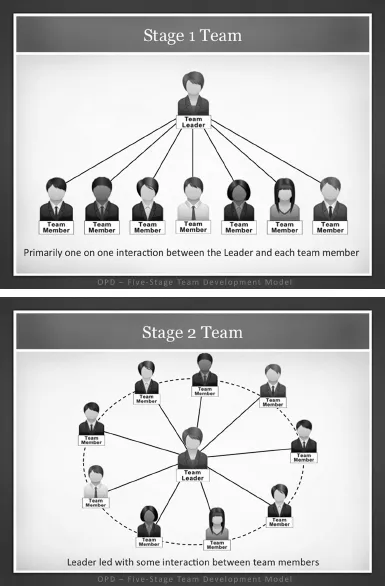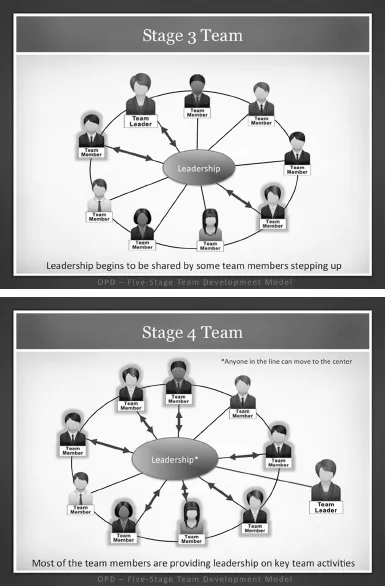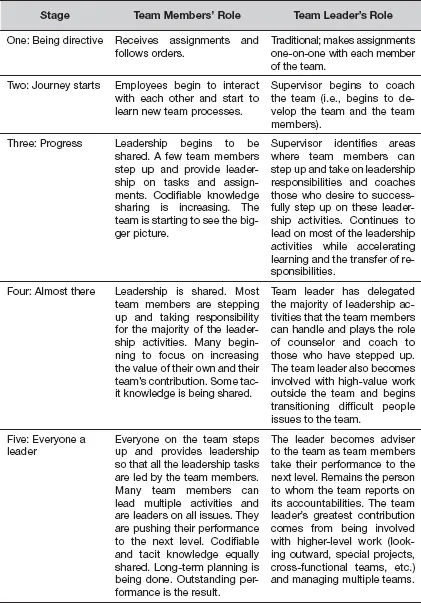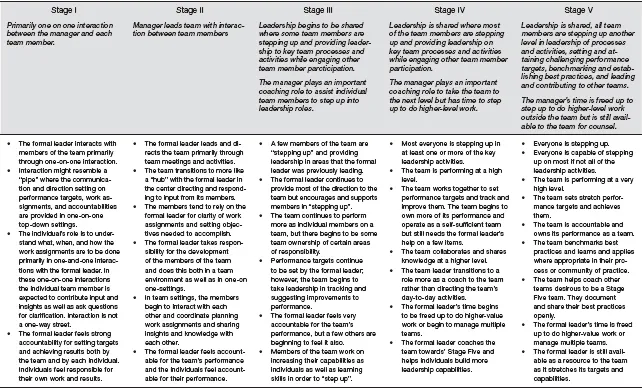![]()
Creating Advantage Through the Five-Stage Team Development Model
Key principle: Leadership always exists in a team; however, everyone becomes a leader once a team achieves Stage Five of the Five-Stage Team Development Model.
THINK OF YOUR CURRENT team or work unit. Is it self-managing? How involved and committed are your team members? How well do you all work together? How many people act as leaders? How much knowledge is shared? Most important, how well is your team/unit performing? If you are using a traditional supervisor–employee model, we strongly suspect that your answers to most, if not all, of these questions will be lukewarm at best.
Our experience and research has shown that the highest performing teams exhibit more self-sufficiency (i.e., self-management) and are more engaged than leader-focused teams. This makes perfect sense because self-managing teams have a greater sense of ownership and employee involvement and often produce better results. While many of the same principles, strategies, tactics, tools, and frameworks generally apply to all types of teams, only well-developed, self-managing teams produce teams of leaders.
If your team is not self-managing and is not producing the results you would like, then this is the time to explore a proven, alternative approach.
SELF-MANAGED WORK TEAMS
A self-managed team is a team of employees working on their own toward a common goal, whose members identify, plan, and manage their daily activities and work under very limited or no supervision. As the team develops, the members do, too, with one of the key objectives being to transform each employee into a committed, highly engaged, flexible, and well-rounded leader.
High-performing self-managed teams retain much greater accountability for their work. Because they often are cross-trained, they are better at problem solving and more flexible in meeting scheduling requirements. In general, multifunctional teams control variances in the process better than functional “silos” because they are more aware of the downstream effects of their mistakes.
To become self-managing, each of your team's members must learn how to accomplish many new tasks, such as planning, scheduling, and performance feedback—tasks that are traditionally performed by supervisors. It's not an easy thing to do. In fact, a common mistake organizations make is to expect work teams to become high-performing right away.
Rather, self-managed teams evolve over a period of months or, more often, years. So don't be surprised if a temporary drop in productivity or morale first precedes the benefits you reap from becoming such a team, as people struggle to change. This book is important because it will explain why the transition is often difficult; at the same time, we will show you how to make the journey as effective and painless as possible.
Once your team truly becomes self-managing, you can expect to deliver improved performance. Moreover, individual results within your team will also get better because people will find the challenge of learning new kinds of management tasks to be very rewarding. Finally, as each team member's role evolves and as your team members become more engaged, possess wider and deeper skills, and start being proactive, they will change from being merely doers to becoming energetic leaders.
THE TEAM DEVELOPMENT MODEL
To accomplish the ambitious goals described, we will focus on one of the real breakthrough tools used by teams to separate themselves from the pack. This framework and tool (influenced by the work of Carl A. Bramlette Jr. and Abe Raab) was discovered when trying to facilitate the natural propensity and desire of team members to move toward building increased capability and self-management.
The Five-Stage Team Development Model allows self-managed teams to develop over time vis-à-vis their relationship with their leader. As teams become more independent, team leaders in turn are freed up to do more development and analysis work. Understanding this development process will make your transition to self-managing teams much smoother.
FIGURE 1-1. The starting point of team development.
A successful self-managed team generally evolves through a series of discernible stages. As you can see in Figure 1-1, at the first stage, your team will start off with virtually every key decision being made by the supervisor or team leader. Because the transition to self-management is going to require a lot of change, the team needs an enormous amount of support.
Some of the initial enthusiasm often gives way to sarcasm as things will not go as smoothly as many people expect. This is why the team leader must be more involved than ever—to ensure that people understand how teams evolve, to address areas of uncertainty, and to deal with issues that the team is not capable of handling.
Slowly, your team will become less leader-focused. As the team moves to Stage Two, it will start to grapple with what its goals and objectives are and try to ensure that everyone is on the same page. Again, this transition usually doesn't happen as quickly as many would like. The team leader will still have to do a lot of coordinating and mentoring as the team begins to take baby steps while the leader begins to gradually move away from exercising full authority.
Stage Three is the midway point in your team's evolution. While there still may be some frustration, members will start to learn their roles and come together. The “big picture” starts to become clearer to the team and its members, and a few individuals will even step up and provide some limited but real leadership. Moreover, the team will start to focus on performance. At the same time, this is also the stage where your team will start to deal with difficult people issues. The supervisor still will be intimately involved in helping to resolve these challenges, because team members usually don't know what to do and are uncomfortable with conflict. (Interestingly, dealing with difficult people is something that most supervisors are not usually comfortable with, either.)
At Stage Four, your team will really start to hum. Most of the team members are able to step up and lead in at least one specific area. People will communicate quite well and learn from each other. They will also take a serious interest in performance and try and actively achieve many of their goals and objectives. In addition, the level of engagement will clearly rise and the team will look to take charge of all its key processes and procedures. By the same token, there will still be work to do, particularly in the areas of problem solving and conflict resolution—two areas that teams generally take longer to become proficient in. You must also continue to work on ensuring that all the team members have the requisite skill sets. At this stage, the supervisor will now be more of a coach and be on a more equal footing with the other team members, and the primary focus becomes training and developing the team members. He will have time to begin to focus on higher order work and contributions.
Once your team reaches Stage Five, it will be at the highest level where the team is self-managing. You will now work together as a unit to set and achieve a challenging set of goals and objectives. Everyone will be involved in team management and in grabbing the bull by the horns in order to get the job done. More important, individual team members will no longer be followers—they will be leaders who look down the road and at their environment in order to get and stay ahead of the curve. Meanwhile, good performance will no longer be acceptable to your team members—they will only accept excellent performance and beyond. Finally, the energy level of the team will be extremely high as its members will know what they need to do, will be committed to doing it, and will work together to provide the best performance possible.
All of this change will allow you, as team leader, to focus on other things besides team performance. Now the leader becomes more of a peripheral member of the team and is free to work on larger issues such as analysis, planning, and cross-functional concerns. Figure 1-2 describes the five stages of this team development model. It depicts 1) the changing roles of the team members and the leader and 2) how everyone becomes a leader.
As you can clearly see, at Stage Five, where everyone is a leader, the roles are strikingly different. People are no longer workers; they are all actively involved in every aspect of the team's operation. Wouldn't you want to be part of a team where everyone is this involved and committed, and where the supervisor actually has time to both scan the environment and look down the road?
FIGURE 1-2. Five-Stage Team Development Model: How everyone becomes a leader.
To make things even clearer, Figure 1-3 is a detailed guide to help you better understand the way your team will develop.
Now that we have explained the model from several different perspectives, let's take a step back and look at several examples of the way teams might evolve under the model.
EXAMPLE: SPECIAL TEAMS UNIT
Our first real-world example is a college football team's Special Teams Unit. Special Teams Units handle kicking plays such as punts, field goals, and kickoffs. Here is how a team expected its unit to develop at each stage.
Stage One
- Special team members understand their objectives through direct instruction from their coach on the field and in meetings.
- Special team members give ideas and recommendations to their coach.
- The coach reviews and interprets special team results and determines priorities and necessary actions, as well as communicates this information either at team meetings or practices (which the coach leads) or in one-on-one meetings.
- The coach determines the depth chart and who is or isn't getting the job done.
- The coach retains most of the ownership of the success or failure of the special team's performance, schemes, and techniques.
FIGURE 1-3. Guide to the Five-Stage Team Development Model.
Stage Two
- Special team members understand their objectives and regularly watch films to review their results.
- The coach leads special team performance review meetings and helps team members to better understand and interpret why they achieved their performance results.
- Team members provide input and discuss results.
- Team members begin to take some responsibility for following up with each other and communicating what can be done to improve and what was talked about in the special teams meetings with the coach.
- Players take some initiative to learn what will help the special teams excel, but the coach continues to determine the depth chart, identify problem performance, and teach schemes and techniques.
Stage Three
- The coaching staff selects special team captains and they begin to take responsibility for certain activities, such as assimilation, training, and performance management.
- Under the direction of the coach, the special team captains recommend special team members (with input from team members) and determine the depth chart, but final approval rests with the coach.
- Special team members undertake the important work of reviewing and analyzing reports and film regularly, while the special team captains run specific team performance review meetings to interpret the results, with help from the coach.
- Special team members are able to identify players they trust to get the job done and provide input to their special team captain. The coach still provides help to sort out the right priorities of each team.
- The coach coordinates with the other areas of the team to make sure the special teams are optimizing their performance; the coach helps facilitate difficult meetings and practices to ensure that time is used effectively.
Stage Four
- The special team captains own the priorities and performance leadership of their teams and follow up as appropriate.
- Facilitated by the special team captains, the special team unit reviews its performance results on a regular basis, with oversight by the coach; only now the players motivate one another.
- The special team owns not only the selection of its members and depth chart, but also the assimilation, training, and performance management of its team members, with some counsel from the coach.
- Others on...






